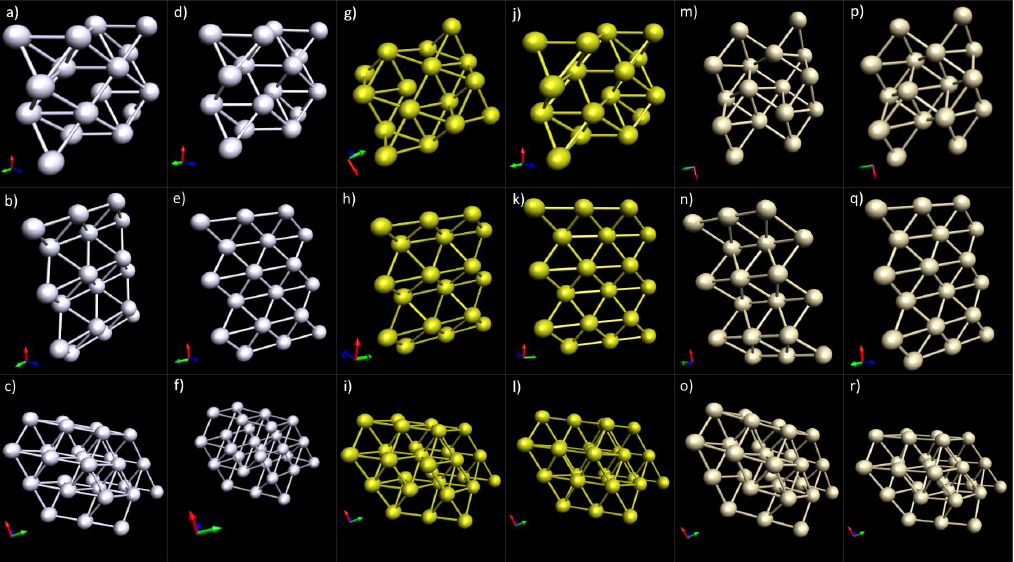Geometry Prediction of Au, Ag, and Pt Nanoparticles Using Density Functional Theory Simulations
Authors: Khoa Nguyen, Arthur Miranda-Huicochea, Rohan Sawhney, Daniel Macaraeg, Claymore McGuire, and David Wong
Department of NanoEngineering, Jacobs School of Engineering, University of San Diego, California
Abstract:
Nanoparticles have become increasingly common in advanced materials science applications, presenting complex and desirable properties which are unique to nanoparticle size and shape. The application-specific selection of metal nanoparticles (NPs) relies on predictable material properties related to the size and shape of the nanoparticle. Many fields of NP application have explored size control and effect on material properties, leaving shape characterization mostly untouched despite its importance. Wulff constructions present a foundation for nanoparticle shape prediction, characterizing NP geometry based on the crystallographic planes of the metal and surface energy minimization. Single crystal representations similarly present a simple basis of NP shape prediction representative of the absolute minimization of surface energy. Given the confined conditions of NPs, density functional theory (DFT) is employed to find the surface energy of each crystal facet and generate a Wulff construction. The shapes predicted within the Wulff constructions roughly correlate with NP shapes previously predicted via computational methods and experimental observations, although further investigations of NP shape based on real conditions are required due to the complexity of nanoscale systems. The elementary information given by the equilibrium shape can be used to balance desired traits in theoretical applications of NPs based on shape and surface energy.
Introduction:
Metal NPs exhibit unique, desirable properties rooted in their confined size and overall irreplicable surface properties compared to their bulk forms. Due to these properties, metal NPs have seen an influx of use across a plethora of applications including drug delivery,1–3 optics,4 biosensors,5,6 catalysis,7 and additive manufacturing.8 Processes of NP synthesis for each application have undergone various optimizations and adjustments to exhibit ideal properties, inevitably approaching an investigation of shape effect and optimization. With most investigations focusing on the effects and control of size, shape control presents a generally unexplored area of NP characterization.
Related to the explicit characteristics of surface energy, volume, and surface area, many specific desirable NP characteristics have been observed to be affected by shape. While mostly investigated for larger nanocrystals via comparisons of nanorods, truncated triangles, and nanospheres, shape presents similar potential for changing characterization and performance at the NP level. The interaction efficiency of NPs in ligand binding and biological targeting have been observed to vary based on the shape of the nanoconstruct core.3,9 Metal NPs are the core structure for many receptor-based nanomedicines with their biocompatibility, but investigations into the efficacy of these treatments display a change with changing core shape alongside size. The addition of shape control as a parameter helps hone the targeting efficiency of drug delivery nanomedicine. Metal NPs in shapes such as spheres, rods, and truncated triangles are among the most investigated based on their ease of synthesis, showing varying performance across biomedical applications. These effects have yet to be quantified, but the basis of correlation supports the need to understand NP shape formation.
Method:
Density Functional Theory (DFT) was applied via Generalized Gradient Approximation (GGA), particularly using the Perdew- Burke-Ernzerhof (PBE) functional in order to investigate the bulk and surface energies of silver, gold, and platinum.13 All calculations under the PBE functional utilized the GBRV pseudopotential library.14 The cell parameters and atomic coordinates for these metal crystals were initially obtained as .cif files from the Materials Project.15–17
The GGA approach is often used in computational materials science due to its electron characterization.13 In contrast to the Local Density Approximation (LDA) model, which assumes a uniform electron density around nuclei, the GGA model incorporates information about the spatial electron density with respect to distance from the nucleus and nucleus charge. While this addition is less important for a periodic bulk metal lattice, which can be modeled as a uniform Fermi gas, this added complexity is vital for reasonable surface calculations where the presence of a vacuum should emphasize electron interaction around the ‘broken bonds’ on the surface.
Results:
The bulk energies computed using SCF calculations were not compared with other experimental values as the parameters and sources of variance were isolated and representative in the final results. The final energies used followed a consistent value convergence based on multiple test runs. Trials using bulk supercells of Au resulted in energy values with insignificant variation from trials using primitive unit cells of Au.
With this understanding and to reduce computation load, the values found using primitive unit cells were used to represent the bulk computations for all of the metals. Similarly, the slab energies were represented by supercells confined to reasonable sizes.
Images of the slabs before and after relaxation. Visualised in Avogadro. From left to right (Unrelaxed -> Relaxed):
Gold (Au), Silver (Ag), Platinum (Pt)
From top to bottom: Planes - (100) (110) (111)
The final Wuff constructions - Top Row:
Gold (Au), Silver(Ag), Platinum(Pt)
Generated by WulffMaker.
Bottom Row:
Gold (Au), Silver(Ag), Platinum(Pt)
Obtained from the Crystalium database.

